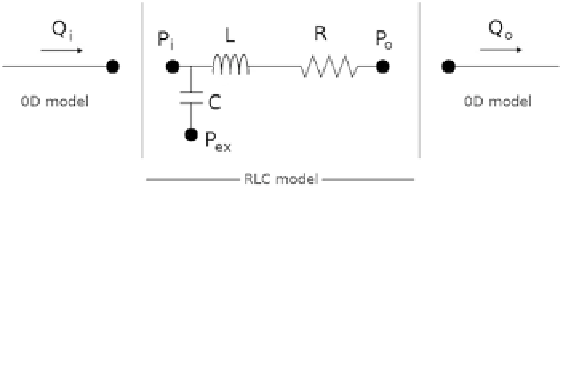Biomedical Engineering Reference
In-Depth Information
Fig. 9.6.
Single-compartment circuit representation
The governing equations for this generic single compartment are
L
dQ
o
dt
+
RQ
o
=
P
i
−
P
o
,
(9.64)
C
d
dt
(
P
i
−
)=
−
.
P
ex
Q
i
Q
o
(9.65)
In particular, the coupling between the venules and the Windkessel models is carried
out using the following equations
N
wub
k
=
1
Q
wub
,
k
=
Q
ubc
P
wub
,
k
=
=
,...,
N
wub
,
P
ubc
k
1
(9.66)
N
wlb
k
=
1
Q
wlb
,
k
=
Q
lbc
P
wlb
,
k
=
P
lbc
k
=
1
,...,
N
wlb
.
(9.67)
In this case the upper and lower venules compartments receive
(
Q
i
,
P
i
)=(
Q
ubc
,
P
ubc
)
and
, respectively. The equations for the remaining compart-
ments are easily obtained from (9.64)-(9.65) by accommodating the notation intro-
duced in Table 9.1.
Table 9.4 and Table 9.5 present the data used in the 0D model of the venous and
pulmonary circulation, respectively.
(
Q
i
,
P
i
)=(
Q
lbc
,
P
lbc
)
9.4.6 Elastance model for the cardiac chambers
Elastance-based modelling of the heart has been adopted in this study to describe
each of the four cardiac chambers. The blood pressure in each cardiac chamber, de-
noted by
P
i
,isgivenby
dV
ch
dt
,
P
i
−
P
ex
=(
E
A
e
(
t
)+
E
B
)(
V
ch
−
V
0
,
ch
)+
α
ch
|
P
i
|
(9.68)
where
V
ch
is the cardiac volume of the chamber and
V
0
,
ch
refers to the dead volume of
such chamber,
α
ch
is a coefficient that incorporates viscoelastic behaviour,
E
A
is the
amplitude of elastance,
E
B
is the baseline value of elastance, and
e
(
t
)
is a normalized



